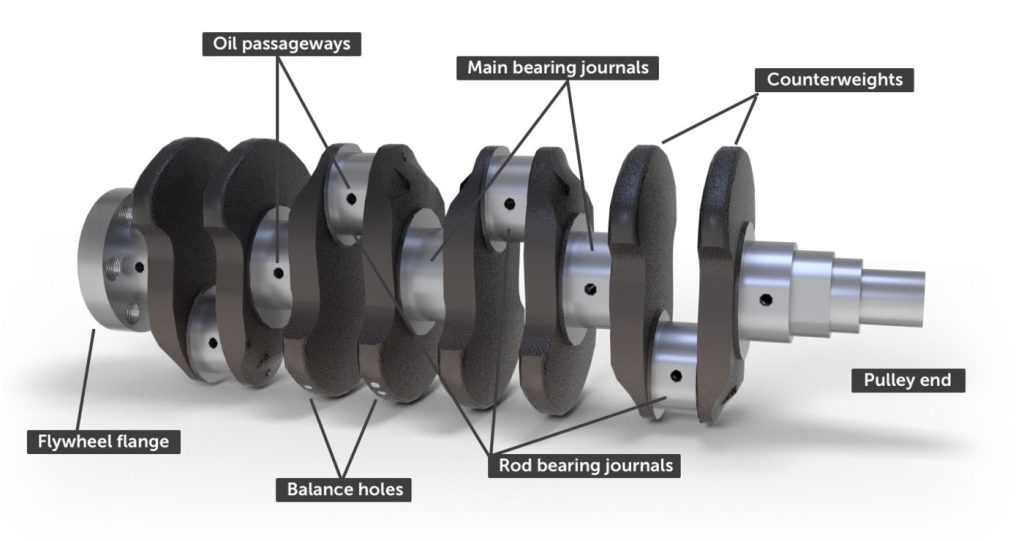Crankshafts are the backbone of any internal combustion engine. Their primary function is to convert the linear motion of pistons into rotational motion, which powers the vehicle. This article will delve into the various components that make up a crankshaft and their importance in the operation of an engine.
Main Journal
The main journal is the part of the crankshaft that is supported by the engine block. It is a cylindrical surface that provides the foundation for the entire crankshaft. The main journal is crucial for maintaining the crankshaft’s stability, and it ensures the proper alignment of all other components.
Crankpin
The crankpin, also known as the connecting rod journal, is a cylindrical surface that connects the connecting rod to the crankshaft. It is responsible for transmitting the linear motion of the piston to the crankshaft, ultimately transforming it into rotational motion. The crankpin’s durability is essential for the overall performance and longevity of the engine.
Counterweights
Counterweights are strategically placed on the crankshaft to balance out the forces generated by the pistons and connecting rods during operation. These counterweights minimize vibrations and help to reduce wear and tear on the engine components. Properly balanced counterweights also contribute to smoother engine performance and increased efficiency.
Crankshaft Webs
Crankshaft webs are the thick sections of material that connect the main journals and crankpins. They provide structural support for the crankshaft and help to maintain its rigidity. Crankshaft webs are designed to withstand the immense forces generated during engine operation and are critical for the crankshaft’s overall strength and durability.
Crankshaft Nose
The crankshaft nose is the front end of the crankshaft, which is connected to the timing gears or timing chain. This connection ensures that the crankshaft rotates in sync with the camshaft, allowing for proper valve timing and overall engine function. The crankshaft nose must be strong and precisely machined to maintain accurate timing and prevent premature engine wear.
Crankshaft Flange
The crankshaft flange is the rear part of the crankshaft, which is connected to the flywheel or flexplate. This connection transmits the engine’s rotational motion to the transmission, which then powers the wheels. The crankshaft flange must be robust and accurately machined to ensure a secure and balanced connection between the engine and transmission.
In conclusion, the various components of a crankshaft work together to ensure the proper functioning of an internal combustion engine. Each component plays a critical role in maintaining the engine’s performance, efficiency, and longevity. Understanding these components and their functions can help diagnose and prevent potential engine problems, ultimately leading to a more reliable and efficient vehicle.
1. Introduction
A brief overview of the crankshaft’s role in internal combustion engines and the purpose of exploring its various components.
2. Main Journal
A concise explanation of the main journal’s function as the foundational support for the crankshaft, its importance for stability, and proper alignment of other components.

Crankpin
A short description of the crankpin’s role in connecting the connecting rod to the crankshaft, transmitting linear motion from the piston, and contributing to the engine’s performance and longevity.
Counterweights
An outline of the purpose of counterweights in balancing the forces generated by pistons and connecting rods, minimizing vibrations, and reducing wear and tear on engine components.
Crankshaft Webs
A summary of the function of crankshaft webs in providing structural support for the crankshaft, maintaining rigidity, and contributing to its overall strength and durability.
Crankshaft Nose
A brief discussion on the crankshaft nose’s connection to timing gears or chains, ensuring synchronized rotation with the camshaft, and its importance in maintaining accurate valve timing and preventing premature engine wear.
Crankshaft Flange
An overview of the crankshaft flange’s role in transmitting the engine’s rotational motion to the transmission, its connection to the flywheel or flexplate, and the importance of a secure and balanced connection.
Conclusion
A succinct wrap-up highlighting the significance of each crankshaft component in maintaining engine performance, efficiency, and longevity, and how understanding these components can help diagnose and prevent potential engine problems.
